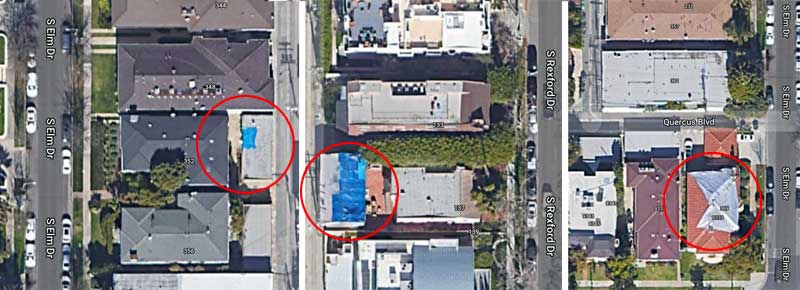Forget Winter – We are in Tarp Season!
Record precipitation hit our region as an ‘atmospheric river’ of water vapor stalled over California. The storm was preceded by a series of advisories from the National Weather Service warning of heavy rain, strong winds, thunderstorms and floods. Some areas saw more than one inch of rain per hour! Indeed the weather folks called last week’s storm the most impressive since 2005. That can present quite a challenge to an old roof!
 However it doesn’t take an ‘atmospheric river’ to expose tenants to heavy weather. It only takes poor maintenance. When rain is driven by strong winds it will force its way through gaps in an aging roof. It will find its way past damaged window frames and sills. Deteriorated paint and siding also allow moisture to penetrate.
However it doesn’t take an ‘atmospheric river’ to expose tenants to heavy weather. It only takes poor maintenance. When rain is driven by strong winds it will force its way through gaps in an aging roof. It will find its way past damaged window frames and sills. Deteriorated paint and siding also allow moisture to penetrate.
Once water finds its way inside it is inevitable that occupants will notice it. There may be discoloration on the ceiling or wall. Water may drip from a ceiling light fixture or dribble through a crack in the ceiling. This is what happens when water accumulates atop the ceiling. Sufficient accumulation it will cause the ceiling to collapse.
Evidence of water penetration should be reported to the landlord immediately and in writing. Indeed the rental agreement likely requires it: failing to reporting such a problem puts the responsibility partially or fully on the tenant. So we have an explainer dedicated to water damage and how to get the landlord to act: Winter Rains Bring Water Leaks: What Should You Do?
Tarp Season
Sometimes the landlord is more concerned with the symptom than the underlying problem. That’s where the tarpaulin comes in: it is a band-aid for water penetration but it won’t ultimately fix what ails a tenant. Even still this approach is not uncommon in Beverly Hills. Indeed we see it every winter. That’s why we we call it tarp season.


A tarpaulin won’t hold off heavy weather and it certainly won’t fix existing water damage — much less any mold that may lurk behind the walls or ceiling. A few years ago we called-out maintenance-by-tarp in an opinion post titled, Tenants Should Not Depend on a Tarp to Keep Dry. Landlords didn’t read it, or they haven’t learned the lesson. So let’s remind them!
Weatherproofing: The Minimum Requirement for Habitability
State law defines tenantable premises as simply “fit for human habitation.” That may helpfully distinguish between an apartment and a farmyard barn, but in our view that is not a satisfactory habitability standard. We said as much earlier this year: ‘Fit for Human Habitation’ is Too Low a Habitability Standard. We recap the bare-bones habitability standards in our cheat sheet: Local and state codes related to multifamily property conditions.
Civil Code § 1941.1(a)(1) for example requires that every residential property provide “effective waterproofing and weather protection of roof and exterior walls.” Because water penetration is known to compromise structural integrity, not to mention threaten the health and safety of occupants, the Health and Safety Code 17920.3(a)(14) also prohibits “general dilapidation or improper maintenance.” If mold is observed it would be regulated under HSC § 17920.3(a)(13).
Locally our Beverly Hills municipal code section 5–7–4 also effectively outlaws property deterioration. Specifically 5-7-4 subsection (B) prohibits peeling paint or damaged exterior coverings that allow water to penetrate. Subsection (O) prohibits cracked, broken, defective or deteriorated exteriors walls. More generally, section 5–7–3 requires all residential premises to be kept in a “safe, clean, orderly, sanitary and aesthetic condition.”
Maintenance: The Landlord’s Responsibility
According to the landlord’s Rights & Responsibilities handbook from Nolo Press, the responsibility for maintaining a dwelling to the tenantable standard rests solely with the landlord. “The tenant’s responsibility to pay rent depends on the landlord’s fulfilling her legal duty to maintain the property and keep it in good repair,” reads the relevant chapter titled The Duty to Repair and Maintain the Property. “Obviously, then, keeping up rental property should be something every landlord takes seriously.”
Indeed a responsible landlord will take seriously something as important as water penetration. However less-than-responsible landlords will pocket the maintenance money and hire a handyman to patch-and-paint and drape the tarp.
But that is not a satisfactory answer to a problem like water penetration. Indeed the $40 tarpaulin is a sign of a much larger policy problem and it concerns the lack of a local habitability standard and the apparent prevalence of poorly-maintained rental properties in Beverly Hills.
So undoubtedly we will continue to see tarps grace our aging but beautiful multifamily properties…and sooner rather than later. Rain is again predicted for this weekend.


